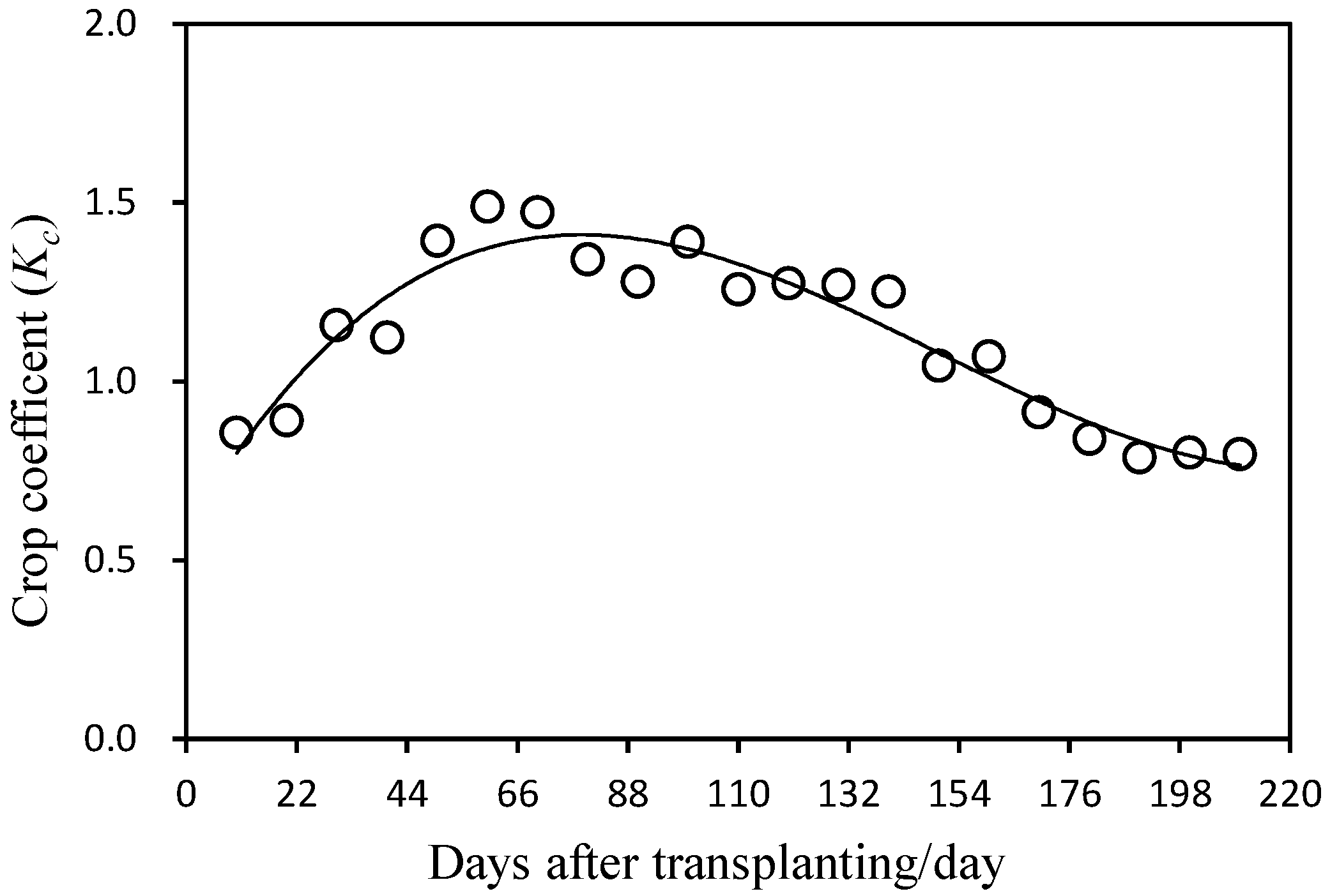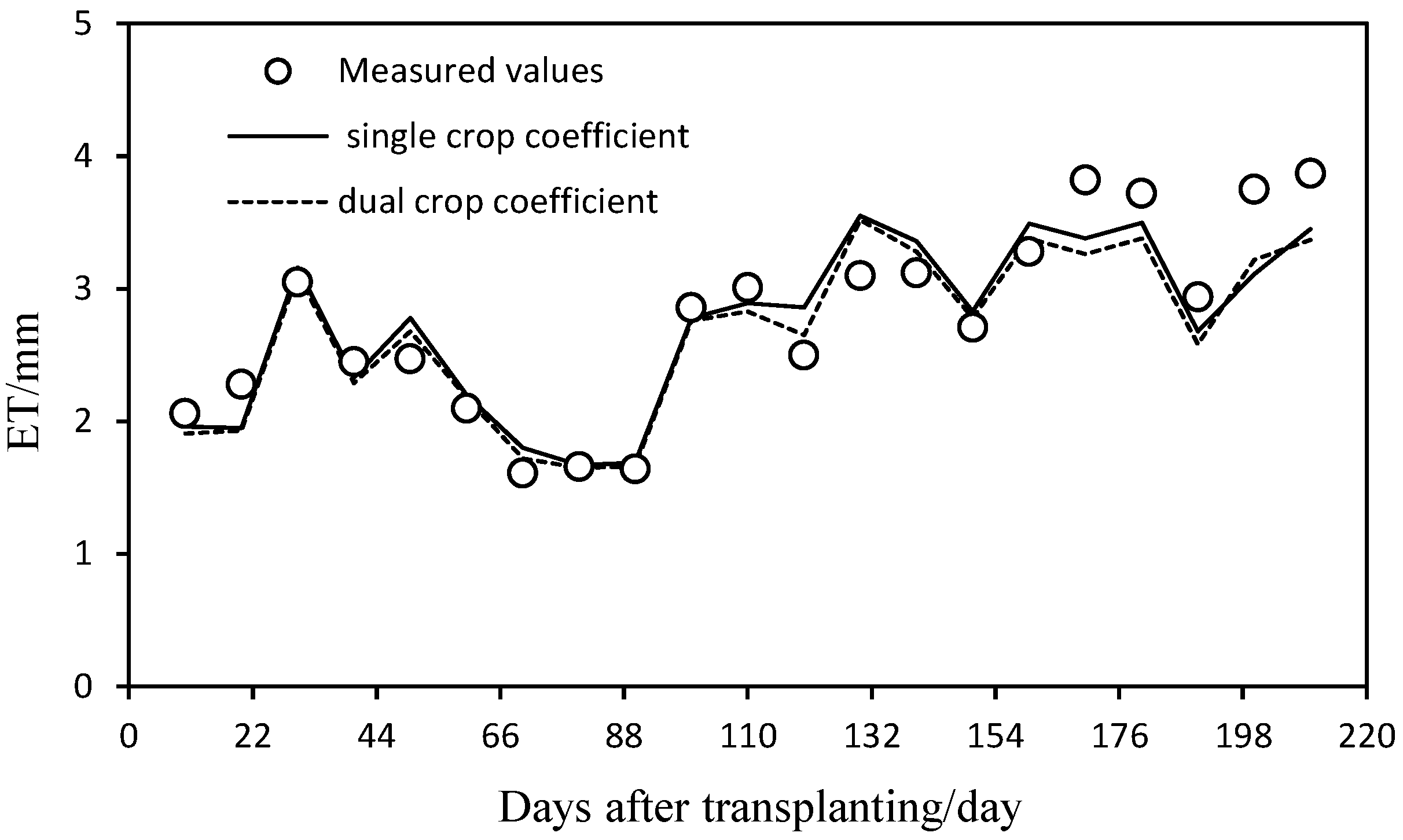Research on Validity Examination of Simulated Results of Eggplant Water Requirements with Drip Irrigation under Mulch in Sunlight Greenhouse
Abstract
:1. Introduction
2. Materials and Methods
2.1. Situation of the Test Area
2.2. Experimental Design
2.3. Content and Methods of Measurement
- (1)
- Greenhouse environment: The solar radiation, net radiation, and relative humidity and air temperature were constantly monitored with an automatic weather station at 2.0 m height above ground level. The solar radiation was measured by a radiometer (LI200X, Campbell Scientific, Inc., Logan, UT, USA), using a net radiometer (LI200X, Campbell Scientific Inc., Logan, UT, USA) to measure net radiation, the air temperature and relative humidity were measured by a temperature and relative humidity recorder (CS215, Campbell Scientific Inc., Logan, UT, USA). The soil heat flux was measured with heat flux plates (HFP01, Hukseflux, Delft, The Netherlands) inserted at 5 cm below the ground surface. All data were collected by a CR1000 data logger (Campbell Scientific Inc., Logan, UT, USA). Additionally, the reference water surface evaporation was also measured with an E601 evaporation pan at the same level.
- (2)
- Soil moisture content: soil water content of 0–80 cm was measured by using a TRIME-IPH time domain reflector (micromodultechnik GmbH, Berlin, Germany). The TRIME-IPH was calibrated before measuring soil moisture content. The methods of calibration are as follows: for the loam under different water conditions, the deviation between the drying method and the TRIME-IPH method was compared, and the maximum deviation of the moisture content measured by TRIME-IPH was less than 0.02 compared with the soil moisture content measured by the drying method. This shows that it was feasible to use the TRIME-IPH to measure the soil water content.
- (3)
- Soil evaporation: micro-lysimeters, which were used to measure soil evaporation, were installed in each plot line of eggplant. The specification of each micro-lysimeter is as follows: it was made from galvanized iron, consisting of an inner cylinder (with a diameter of 10 cm) and an outer cylinder (with a diameter of 11 cm), with a thickness and height of 0.5 cm and 35 cm, respectively. The inner cylinder was weighed daily at 8 a.m. using an electronic balance with a precision of 0.1 g, and the soil of the inner tank was replaced every two days, as well as after irrigation. Three replications were set for each plot.
- (4)
- Crop height: eggplant height was measured every observed day using a ruler. The range of measurement was from the soil surface to the highest position of the canopy.
3. Methods of Crop Water Requirement Measurement
3.1. Actual Crop Water Requirement
3.2. Reference Crop Water Requirement
3.3. Single Crop Coefficient
3.4. Dual Crop Coefficient
3.5. Model Validation
- (1)
- Correlation index R2. If R2 was closer to 1, it indicated that the variability of the observed value can be solved by the simulation model:where Qi is the actual observation values; is the mean value of measured value; Pi is the predictive value of the model; and was the mean value of predicted value.
- (2)
- Regression coefficient b. If b was closer to 1, it indicated that the predicted value was closer to the actual value:
- (3)
- Average absolute error, MAE:
- (4)
- Average standard error, RMSE:
- (5)
- Variance of the residual, Var(ER):
- (6)
- Relative deviation of the consistency index, dIA:
4. Results and Analysis
4.1. Changes of the Measured Crop Coefficient
4.2. Values of Single and Dual Crop Coefficients
4.3. Model Validity Test
5. Conclusions
- (1)
- The crop coefficient can be calculated by using the measured data in the greenhouse. The crop coefficient was 0.86 in the early stage of growth, 1.49 in the middle stage and 0.8 in the late stage.
- (2)
- The change rules between simulated crop water requirement of the single and dual crop coefficient method and measured crop water requirement in the whole growth period were consistent, and the deviation between them was small.
- (3)
- The regression coefficient and correlation coefficient between the simulated values by the single and dual crop coefficient method and measured values were obtained by the regression analysis method. With the single crop coefficient method, the regression coefficient b was 0.8281, and R2 was 0.8374; with the dual crop coefficient method, the regression coefficient b was 0.8220, R2 was 0.8597, and the fitting degrees of the two models were both good.
- (4)
- The degree of deviation between the simulated values and the measured values of the single and dual crop coefficient methods were given quantitatively by the error indication method of residual error estimation. With the dual crop coefficient method, MAE was 0.2196 mm/day, RMSE was 0.27 mm/day, and Var(ER) was 0.0685, which were all smaller than the values of single crop coefficient method. The dual crop coefficient method of dIA was 0.9543 which was larger than the single crop coefficient method of dIA that was 0.9530, and it showed that the crop water requirement calculated by the dual crop coefficient method was closer to the measured crop water requirement.
- (5)
- Although the test object and test conditions were relatively limited, the research results of the crop water requirement model can be used to determine water savings and the high efficiency irrigation system of crops. When applied in other regions, it should be revised according to the specific local conditions in order to improve the accuracy of the simulation.
Acknowledgments
Author Contributions
Conflicts of Interest
References
- Wang, F.; Du, T.S.; Qiu, R.J.; Dong, P.G. Effects of deficit irrigation on yield and water use efficiency of tomato in solar greenhouse. Trans. Chin. Soc. Agric. Eng. 2010, 26, 46–52. [Google Scholar]
- Allen, R.G.; Pereira, L.S.; Raes, D.; Smith, M. Crop Evapotranspiration—Guidelines for Computing Crop Water Requirements; FAO Irrigation and Drainage Paper 56; Food and Agriculture Organization: Rome, Italy, 1998. [Google Scholar]
- Abedikoupai, J.; Eslamian, S.S.; Zareian, M.J. Measurement and modeling of water requirement and crop coefficient for cucumber, tomato and pepper using microlysimeter in greenhouse. J. Sci. Technol. Greenh. Cult. 2011, 2, 51–64. [Google Scholar]
- Razmi, Z.; Ghaemi, A.A. Crop and soil-water stress coefficients of tomato in the glass-greenhouse conditions. J. Sci. Technol. Greenh. Cult. 2011, 2, 75–87. [Google Scholar]
- Qiu, R.J.; Song, J.; Du, T.S.; Kang, S.Z.; Tong, L.; Chen, R.S.; Wu, L.S. Response of evapotranspiration and yield to planting density of solar greenhouse grown tomato in northwest China. Agric. Water Manag. 2013, 130, 44–51. [Google Scholar] [CrossRef]
- Odhiambo, L.O.; Irmak, S. Evaluation of the impact of surface residue cover on single and dual crop coefficient for estimating soybean actual evapotranspiration. Agric. Water Manag. 2012, 104, 221–234. [Google Scholar] [CrossRef]
- Yu, C.; Chao, L.B.; Gao, R.Z.; Zhu, Z.Y. Validity examination of simulated results of crop water requirements. Trans. Chin. Soc. Agric. Eng. 2009, 25, 13–21. [Google Scholar]
- Feng, Y.; Cui, N.B.; Gong, D.Z.; Wang, H.B.; Hao, W.P.; Mei, X.R. Estimating rainfed spring maize evapotranspiration using modified dual crop coefficient approach based on leaf area index. Trans. Chin. Soc. Agric. Eng. 2016, 32, 90–98. [Google Scholar]
- Liu, Y.W.; Zhu, Z.Y.; Wu, Y.J.; Jing, Y.L. Comparison of evapotranspiration of the Natural Vegetation in the Otindag Sandy Area Using Two Calculation Methods. Trans. Chin. Soc. Agric. Mach. 2010, 41, 84–88. [Google Scholar]
- Poblete-Echeverría, C.A.; Ortega-Farias, S.O. Evaluation of single and dual crop coefficients over a drip-irrigated Merlot vineyard (Vitis vinifera L.) using combined measurements of sap flow sensors and an eddy covariance system. Aust. J. Grape Wine Res. 2013, 19, 249–260. [Google Scholar] [CrossRef]
- Qiu, R.J.; Du, T.S.; Chen, R.Q. Application of the dual crop coefficient model for estimating tomato evapotranspiration in greenhouse. J. Hydraul. Eng. 2015, 6, 678–686. [Google Scholar]
- Gong, X.W.; Liu, H.; Sun, J.S.; Ma, X.J.; Wang, W.N.; Cui, Y.S. Modeling evapotranspiration of greenhouse tomato under different water conditions based on the dual crop coefficient method. Chin. J. Appl. Ecol. 2017, 28, 1255–1264. [Google Scholar]
- Liu, Y.; Wang, L.; Ni, G.H.; Cong, Z.T. Spatial distribution characteristics of irrigation water requirement for main crops in China. Trans. Chin. Soc. Agric. Eng. 2009, 25, 6–12. [Google Scholar]
- Zhang, B.; Yuan, S.Q.; Cheng, L.; Yuan, J.; Cong, X. Model for predicting crop water requirements by using L-M optimization algorithm BP neural network. Trans. Chin. Soc. Agric. Eng. 2004, 20, 73–76. [Google Scholar]
- Wu, Y.L.; Tian, G.Z.; Wang, Y.F. Analysis of crop water requirement based on refined SEBS model. Agric. Res. Arid Areas 2015, 1, 113–118, 193. [Google Scholar]
- Su, M.S.; Li, J.S.; Rao, M.J. Estimation of crop coefficients for sprinkler-irrigated winter wheat and sweet corn using a weighing lysimeter. Trans. Chin. Soc. Agric. Eng. 2005, 21, 25–29. [Google Scholar]
- Fan, Y.Q.; Cai, H.J. Comparison of crop water requirements computed by single crop coefficient approach and crop coefficient approach. J. Hydraul. Eng. 2002, 3, 50–54. [Google Scholar]
- Wang, S.S.; Fei, L.J.; Gao, C.C. Experiment on single crop cofficient of summer maize under different furrow irrigations. Trans. Chin. Soc. Agric. Eng. 2013, 44, 105–111. [Google Scholar]
- Orgaz, F.; Ferna’ndez, M.D.; Bonachela, S.; Gallardo, M.; Fereres, E. Evapotranspiration of horticultural crops in an unheated plastic greenhouse. Agric. Water Manag. 2005, 72, 81–96. [Google Scholar] [CrossRef]
- Chen, X.M.; Cai, H.J.; Li, H.X.; Wang, J.; Du, W.J. Calculation of crop evapotranspiration in greenhouse. Chin. J. Appl. Ecol. 2007, 18, 317–321. [Google Scholar]
- Willmott, C.J.; Matsuura, K. Advantages of the Mean Absolute Error (MAE) over the Root Mean Square Error (RMSE) in Assessing Average Model Performance. Clim. Res. 2005, 30, 79–82. [Google Scholar] [CrossRef]
- Ge, J.K.; Li, H.H.; Peng, C.W. Research on crop coefficient of eggplant with drip irrigation under mulch in sunlight greenhouse. J. Irrig. Drain. 2015, 34, 59–62. [Google Scholar]
- Vu, S.H.; Watanabe, H.; Takagi, K. Application of FAO-56 for evaluating evapotranspiration in simulation of pollutant runoff from paddy rice field in Japan. Agric. Water Manag. 2005, 76, 195–210. [Google Scholar] [CrossRef]



| Method | R2 | MAE | RMSE | dIA | b | Var(ER) |
|---|---|---|---|---|---|---|
| Single crop coefficient | 0.8374 | 0.2335 | 0.2800 | 0.9530 | 0.8281 | 0.0785 |
| Dual crop coefficient | 0.8597 | 0.2196 | 0.2700 | 0.9543 | 0.8220 | 0.0685 |
© 2018 by the authors. Licensee MDPI, Basel, Switzerland. This article is an open access article distributed under the terms and conditions of the Creative Commons Attribution (CC BY) license (http://creativecommons.org/licenses/by/4.0/).
Share and Cite
Wang, S.; Li, B.; Gong, X. Research on Validity Examination of Simulated Results of Eggplant Water Requirements with Drip Irrigation under Mulch in Sunlight Greenhouse. Water 2018, 10, 130. https://doi.org/10.3390/w10020130
Wang S, Li B, Gong X. Research on Validity Examination of Simulated Results of Eggplant Water Requirements with Drip Irrigation under Mulch in Sunlight Greenhouse. Water. 2018; 10(2):130. https://doi.org/10.3390/w10020130
Chicago/Turabian StyleWang, Shunsheng, Bo Li, and Xuewen Gong. 2018. "Research on Validity Examination of Simulated Results of Eggplant Water Requirements with Drip Irrigation under Mulch in Sunlight Greenhouse" Water 10, no. 2: 130. https://doi.org/10.3390/w10020130





